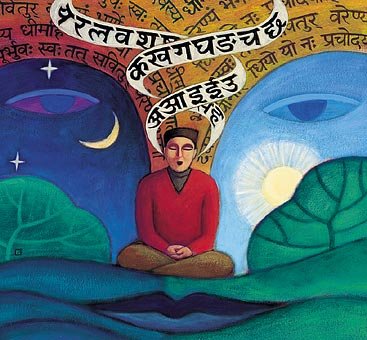Dr. Laxmichand Deveriya has come up with a methodology where speaker can learn a language by emulating vocabulary and syntax structures without having any active awareness of grammar.
In line with the basic commandment of an era characterised by ethnic fragmentation, cultural disintegration and dismantling of common sense-fed popular concepts, language competence can be acquired without rote memorisation of grammatical rules. People, who invariably take delight in situational comedy, can now get their hands on a language by getting acquainted themselves with semantic lessons in different situations.
This has been aptly articulated by a famous scholar Dr. Laxmichand Deveriya in his recently published monograph “Situational Sanskrit”. Certainly more than a run-of-the mill manual of teaching language or language-made-simple type book, Dr. Deveriya meticulously tries to resuscitate Sanskrit as a language of common conversation.
Armed with a doctorate in Sanskrit linguistics and post-graduate degree in linguistics and a reasonable proficiency in Arabic and French (A polyglot in true sense), Dr. Deveriya exposes the readers to a methodology that speaker can learn a language by emulating vocabulary and syntax structures without having any active awareness of grammar.
The author cites the example of migrants living in the West Asia learn conversational Arabic quite successfully not paying any heed to the grammatical structures that constitute Arabic. Peeved at the plight of a language regarded as “Mother of Linguistics” and a unique language for computer programming (Noam Chomsky), the author compiled a useful text with graded emphasis on vocabulary clearly indicating that the students of modern science and information technology can converse in Sanskrit in different situations. Delineating what inspires him to undertake this innovate project, Dr. Deveriya says, “What made me tick was the linguistic wander of Hebrew which had no native speakers till the formation of Israel after World War II but was elevated as a medium of instruction for higher education. Equally flabbergasting was the case of Finnish (which had native speakers but no script) that too was elevated to the status of medium of instruction for higher education. These two instances inspired me a great deal to undertake similar innovations for Sanskrit which has both-Devanagari script as well as a good number of speakers.”
Divided into 20 functional lessons each set in a different situation, the book is braced for equipping the readers with communicative competence in a language that links us with the cerebral legacy of our past. The author really took pains in finding easy-to understand Sanskrit equivalents for many concepts of information technology driven post-modern world. At places the author seems relying too much on Sanskrit morphemes as he feared that frequent bearings from other languages will not go well with Sanskrit scholars. For semantic exigency, Dr. Deveriya worked with an erudité scholar of applied linguistics Dr. Kshirsagar whose Paanian explication blazed a new trail in linguistic studies globally.
The author perceptively envisages 27 real life situations pertaining to family and relations, time division, number and its counting, meals and food habits, trade, business, profession, dress style, concepts of modern psychology, greetings and felicitation, travel, commercials concepts, terminology used in courts and newspapers land Indian elections, etc. The book provides the readers with handy vocabulary and syntax structures that will tempt them to use Sanskrit in day-to-day conversation.
In a society that has been marching towards mono-lingualism, the brilliantly written book explores new dimensions of glocalisation that enables us to join the war against the totality. The book based on the author’s Ph.D. thesis titled “Innovations in the methodology of Sanskrit teaching” proves the efficacy of the ever- increasing adoption of direct method of teaching a language. New generation trained in anglophile tradition of language learning may feel the need of transliteration of Sanskrit text.






